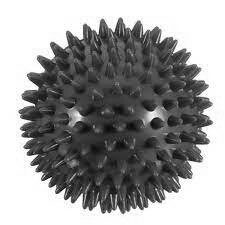Massage is an inherent component of the physiotherapy profession, and teaching patients to self massage is a strategy that allows for treatment to continue at home. But self massage has limitations, not least the inability to acces parts of the body that are out of reach.
At the end of the 20th century the spiky ball entered the physiotherapy industry. Mass produced in China, it is a firm plastic ball about 9 centimetres in diameter, with cone shaped protuberances. The spiky ball was not the first self massage tool but its innovative combination of ‘spikes’ on a sphere provided for both stability and mobility, essential elements for the operator to be able to control the movement of the ball.
Placed between the wall or floor and the body part to be massaged, the depth of the massage can be controlled by how much body weight the patient put on the ball and the area of the massage could be controlled by how much the patient moved their body. The relative ease of this body weight technique makes the spiky ball a simple and effective self massage tool.
The genesis of the spiky ball is unknown, but it has become ubiquitous in modern musculoskeletal physiotherapy practice. The benefits of mass production make it a cheap tool that patients can easily use at home.
Description provided by Glenn Ruscoe of Australia.

